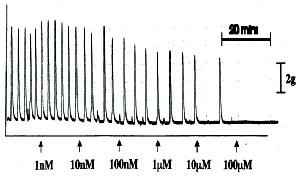| 2002 |

|
YEAR BOOK |
Health Research Board & National University of Ireland, Galway
|
COX-2 and human labour – term and preterm
|

It is well established that prostaglandins are closely linked to the onset and maintenance of human labour. Prostaglandins are formed by way of the cycloxygenase (COX enzymes). There are two isoforms of the cyclooxygenase enzymes, COX-1 and COX-2. They are both encoded by different genes. It is believed that COX-2 plays a more central role in the onset of human labour. This project, which was funded by the HRB, was designed with the following objectives:
-
To investigate expression of COX-2 in placenta and fetal membranes at the time of human labour.
-
To investigate the effects of COX-2
inhibition on human pregnant myometrial (uterine) contractility.
-
To examine the hypothesis that COX-2 inhibitors, which exhibit varying COX-2 selectivity, may have a varying effect on contractile activity of human myometrium.
Data from this kind of scientific study are essential to finding solutions to the problem of premature labour and its significant clinical sequelae (Slattery M.M., Friel A.M., Healy D.G., Morrison J.J., Uterine relaxant effects of Cyclooxygenase-2 inhibitors in vitro. Obstet Gynaecol, 2001, 98, 563-569).
Participants: Professor John J. Morrison, Professor of Obstetrics and Gynaecology; Professor Terry Smith, Professor of Biomedical Engineeering Science; Ms Anne M. Friel, PhD Student (funded for two years by HRB); Dr Michael M. Slattery, SHO, Obstetrics and Gynaecology.
Contact: Professor John J. Morrison, Professor of Obstetrics and Gynaecology,
Clinical Science Institute,
National University of Ireland, Costello Road, Galway;